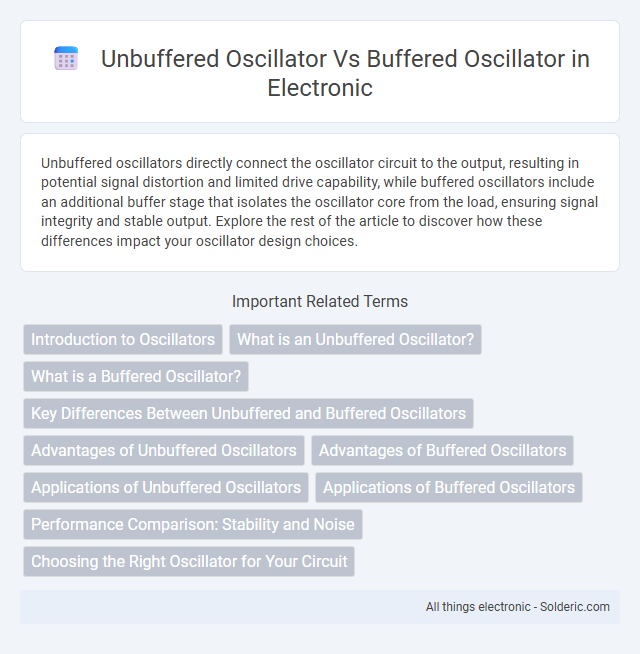Unbuffered oscillators directly connect the oscillator circuit to the output, resulting in potential signal distortion and limited drive capability, while buffered oscillators include an additional buffer stage that isolates the oscillator core from the load, ensuring signal integrity and stable output. Explore the rest of the article to discover how these differences impact your oscillator design choices.
Comparison Table
| Feature | Unbuffered Oscillator | Buffered Oscillator |
|---|---|---|
| Signal Output | Direct Oscillator Output | Output Passes Through a Buffer Stage |
| Load Driving Capability | Low; Sensitive to Load Variations | High; Stable Under Load |
| Signal Integrity | Potentially Degraded by Load | Maintains Signal Quality |
| Frequency Stability | Lower Stability due to Loading Effects | Improved Stability from Isolation |
| Complexity | Simpler Circuit Design | More Complex due to Additional Buffer |
| Power Consumption | Lower Power Usage | Higher Power Usage due to Buffer Stage |
| Applications | Suitable for Low Load, Simple Circuits | Preferred for High Load or Sensitive Circuits |
Introduction to Oscillators
Unbuffered oscillators generate a raw output signal directly from the oscillator circuit, often resulting in higher signal distortion and instability. Buffered oscillators include a buffer stage that isolates the oscillator from the load, providing a stable output with reduced distortion and improved signal integrity. Choosing the right oscillator for your circuit depends on whether signal purity or simplicity is your priority.
What is an Unbuffered Oscillator?
An unbuffered oscillator directly drives the output stage without an intermediate buffer, resulting in a simple design with lower power consumption and reduced propagation delay. This configuration allows your oscillator signal to have a more immediate response but may be more susceptible to noise and load variations. Compared to buffered oscillators, unbuffered types offer higher sensitivity yet require careful circuit design to maintain signal integrity.
What is a Buffered Oscillator?
A buffered oscillator includes a buffer amplifier stage that isolates the oscillating circuit from the output, maintaining signal integrity and preventing load effects from disrupting frequency stability. This buffering ensures your oscillator produces a consistent output signal even when driving low-impedance loads or complex circuits, improving overall performance. Unbuffered oscillators lack this isolation, often resulting in signal distortion and frequency variability due to load interactions.
Key Differences Between Unbuffered and Buffered Oscillators
Unbuffered oscillators directly feed the output signal without isolation, leading to potential signal distortion and loading effects on the oscillator circuit, whereas buffered oscillators incorporate a buffer stage that isolates the output from the oscillator core to maintain signal integrity and stability. Buffered oscillators provide improved drive capability and reduced susceptibility to noise, making them suitable for driving multiple loads or long transmission lines, while unbuffered designs are simpler but prone to signal degradation under load. Your choice between unbuffered and buffered oscillators depends on the required signal fidelity and load-driving requirements in your application.
Advantages of Unbuffered Oscillators
Unbuffered oscillators offer lower power consumption and reduced phase noise compared to buffered oscillators, making them ideal for high-precision timing applications. Without the buffering stage, signal integrity remains closer to the original oscillation, ensuring higher frequency accuracy and stability. You benefit from simpler circuit design and faster response times in unbuffered oscillator configurations.
Advantages of Buffered Oscillators
Buffered oscillators provide greater signal stability by isolating the oscillator core from load variations, ensuring more accurate frequency output. Your circuit benefits from improved impedance matching and reduced loading effects, enhancing overall performance. These oscillators also enable easier integration with other components without degrading signal quality.
Applications of Unbuffered Oscillators
Unbuffered oscillators are commonly used in applications requiring direct signal generation without output isolation, such as integrated circuit timing references and sensor signal processing. Their simple design allows for low power consumption and minimal propagation delay, making them ideal in low-frequency clock generation and test signal sources. These oscillators are preferred in analog circuits where minimal signal distortion and direct interaction with other components are essential.
Applications of Buffered Oscillators
Buffered oscillators are widely used in applications requiring stable signal isolation and impedance matching, such as clock generation in microcontrollers and digital logic circuits. Their buffered output provides drive capability for multiple loads without signal degradation, making them essential in timing-sensitive environments like communication systems and synchronized data acquisition. These oscillators are crucial in scenarios demanding low noise and minimal loading effects, enhancing overall circuit reliability.
Performance Comparison: Stability and Noise
Unbuffered oscillators typically exhibit higher noise levels due to the lack of isolation from subsequent circuit stages, which can result in greater signal distortion and reduced stability over time. Buffered oscillators incorporate a buffer stage that enhances stability by isolating the oscillator core from load variations, thereby minimizing noise and maintaining consistent frequency output. Your choice between the two affects overall circuit performance, with buffered oscillators offering superior noise immunity and frequency stability crucial for precise applications.
Choosing the Right Oscillator for Your Circuit
Unbuffered oscillators provide a direct output with minimal delay, making them ideal for high-speed, low-noise applications where signal integrity is critical. Buffered oscillators include an amplifier stage that stabilizes the output and improves drive capability, suited for circuits requiring stronger signals or protection against load variations. Selecting the right oscillator depends on the specific requirements of your circuit, including signal purity, load driving needs, and overall system stability.
Unbuffered oscillator vs Buffered oscillator Infographic

 solderic.com
solderic.com